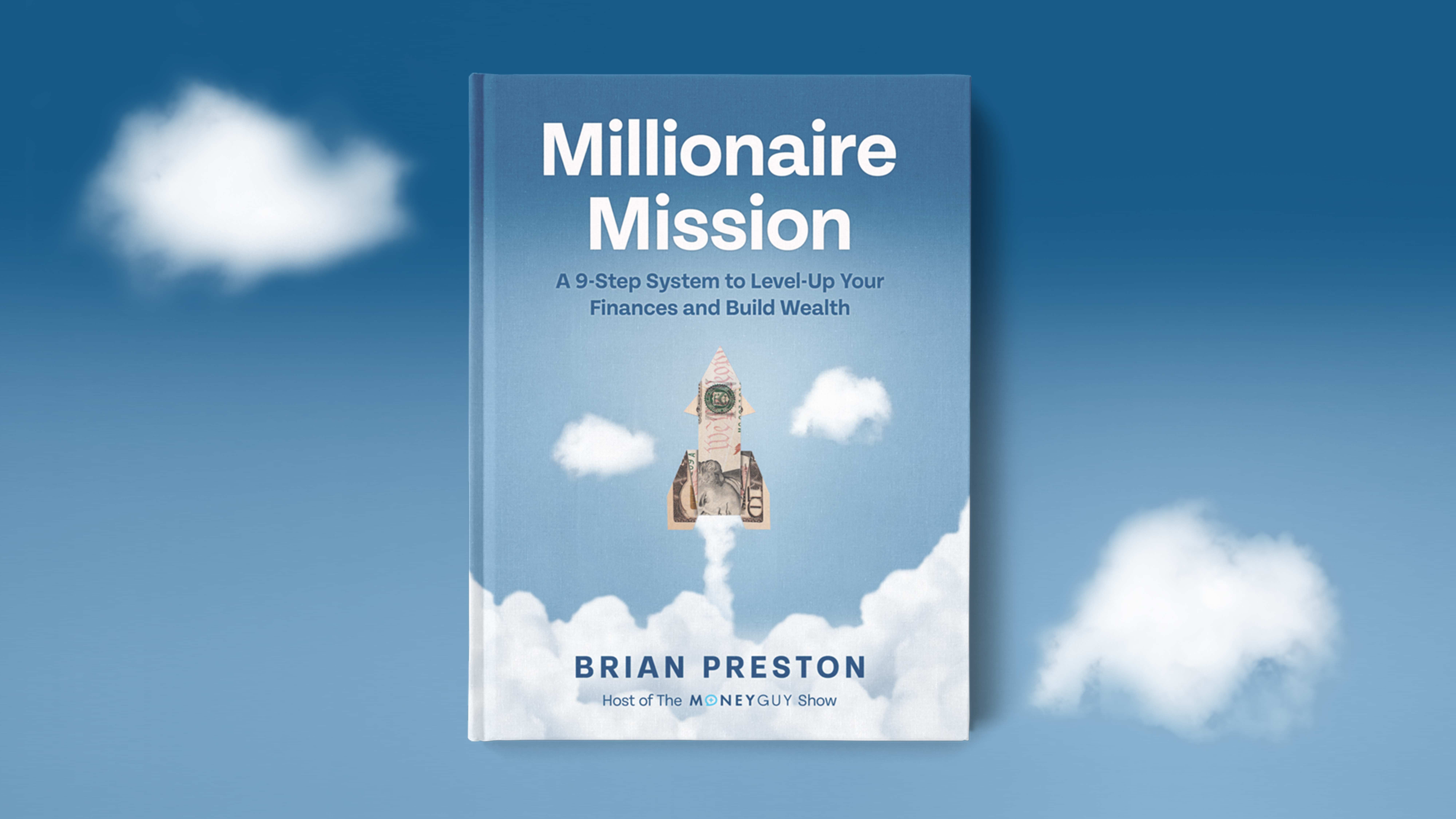
Change your life by
managing your money better.
Subscribe to our free weekly newsletter by entering your email address below.

Subscribe to our free weekly newsletter by entering your email address below.
We’re talking about the eighth wonder of the world: compound interest. You know it. That’s my girlfriend. You’ll love it. But how well can you explain it?
We’re going to walk you through this foundational principle of wealth building, breaking it down into five layers of complexity. This one’s for folks new to investing and fellow math nerds. So no matter where you are, listen up and lean in.
Make sure you stick around to the end because we’re going to show you how to make compound interest work for you and your financial life—with a brand-new tool that we just released and designed.
And after we’re through, let us know in the comments:
What level you’re at
When you started
What you’ve learned along the way
With that, let’s dive right in.
Imagine you put $1 into a magic piggy bank. When you come back the next day, there’s another dollar inside—just because you put the first one in. The next day, instead of just adding one more dollar, the magic piggy bank gives you two extra dollars, because now you have $2 inside.
Every day, the piggy bank is adding money faster and faster. That’s how compound interest works: your money keeps making more money, even when you’re not looking.
To the hard-hearted trolls: Yes, these numbers are overly simple and the returns are unrealistic in such a short period. But remember—this is a magic piggy bank… likely shaped like a unicorn.
Let’s break down the term itself:
Compound interest is the idea of earning interest not just on the money you originally saved, but also on the interest you’ve already earned.
Save $100 and earn 10% interest.
After one year, that becomes $110 ($100 + $10 interest).
The next year, you earn 10% on $110, not just $100.
That gives you $11 in interest, bringing your total to $121.
See what’s happening? The interest you earned last year is also earning interest. That’s why it’s called compounding. If it sounded mysterious before, now you know.
Let’s get into the actual math of how this works. Don’t let your eyes glaze over—this can change the direction of your life.
A=P×(1+rn)ntA = P \times \left(1 + \frac{r}{n} \right)^{nt}
Where:
P = Principal (the amount you started with)
r = Rate of return
n = Number of compounding periods per year (e.g., 12 for monthly)
t = Time in years
Let’s walk through an example.
Age: 20-year-old investor
Principal: $1
Interest rate: 10% (0.10)
Compounding frequency: Monthly (n = 12)
Time horizon: Until age 65 (45 years)
Using the formula, $1 grows to $88 over that time.
At its core, the math of compound interest is based on the time value of money—the idea that a dollar today is worth more than a dollar tomorrow.
Why? Because you can invest today’s dollar and let it grow through compound interest.
This is how:
You earn interest on your principal
Then you earn interest on that interest
Over time, your money starts doing the heavy lifting
We like to think about this as the wealth multiplier—a concept that shows how every dollar you invest today can multiply dramatically by retirement.
Invest $1 at age 20 → grows to $88
Wait until age 30 → only grows to $23
That’s why we say it over and over:
Start now.
Every dollar invested early has the potential to become many dollars in the future.
Sometimes, you just want to know how fast your money will double. That’s where the Rule of 72 comes in:
Divide 72 by your expected annual return
Example: 10% return → 72 ÷ 10 = 7.2 years to double
This helps visualize how quickly disciplined savings can turn into lasting wealth.
Understanding:
The time value of money
The wealth multiplier
The Rule of 72
…all points to one powerful truth:
Time is your most valuable asset in building wealth.
Start early. Let your money grow more efficiently. Set the stage for long-term financial independence.
This is where compound interest becomes personalized.
How does compound interest apply to your situation?
The most advanced understanding is knowing how to use it to build a life of financial freedom tailored to your goals.
And the best way to do that is with our brand new tool:
This calculator lets you adjust:
Starting amount
Interest rate
Monthly contributions
Time horizon
Compounding frequency
You’ll see exactly how your money grows.
This section is eye-opening. Even a $100 increase in monthly savings can dramatically increase your final balance.
A coffee’s worth of extra savings per day can mean hundreds of thousands more at retirement.
This tool helps you visualize your path to financial independence.
Compound interest is the simplest yet most profound concept in personal finance.
Whether it’s:
A child with a magic piggy bank
Or a seasoned investor managing millions
The same principle applies:
Money makes money over time.
The earlier you start, the more dramatic the results. Modest, consistent contributions can transform into life-changing wealth.
But it only works if you take action.
Every day you delay is a day of lost growth.
So whether you’re at level 1 or level 5:
Understand the principle
Use the calculator
Start putting compound interest to work today
And keep building toward your great big beautiful tomorrow.
Subscribe on these platforms or wherever you listen to podcasts! Turn on notifications to keep up with our new content, including:
We’re talking the eighth wonder of the world: compound interest. You know it. That’s my girlfriend. You’ll love it. But how well can you explain it?
We’re going to talk you through this foundational principle of wealth building in five layers of complexity. This one’s for the folks new to investing and my fellow math nerds. So no matter where you are, listen up and lean in. Make sure you stick around to the end, because we’re going to show you how you can make compound interest work for you and your financial life with a brand new tool that we just released and designed.
And after we’re through with all of them, let us know in the comments what level you’re at, when you started, and what you learned along the way. With that, let’s dive right in.
Level number one — an explanation for the kiddos.
Imagine you put $1 into a magic piggy bank. When you come back the next day, there’s another dollar inside just because you put that first one in. The next day, instead of just adding one more dollar, the magic piggy bank gives you two extra dollars because now you have $2 inside. Every day, the piggy bank is adding money faster and faster. That’s how compound interest works. Your money keeps making more money even when you’re not looking.
To the hard-hearted trolls, I recognize that these numbers might be overly simple and the returns in such a short period of time are completely unrealistic, but remember — this is a magic piggy bank likely shaped like a unicorn.
Level two.
We’re going to take it up to a high school level and get a little more advanced, including breaking down the term itself. Compound interest is the idea of earning interest not just on the money you originally saved, but also on the interest you’ve already earned.
For example, let’s say you save $100 and earn 10% interest. After one year, your $100 becomes $110 — that’s $10 of interest. But the next year, you don’t just earn interest on your original $100. Instead, you earn interest on the whole $110. So now, at 10%, you’ll earn $11 in interest, bringing you up to $121. See what’s happening? The interest you earned last year is also earning interest. In other words, this interest compounds. This is where we get the term.
If you’ve heard the term thrown around but it felt shrouded in mystery, now you know.
Level three — college level math.
Let’s get into a college-level explanation with the actual math behind how this works. And before your eyes glaze over because I used the word “math,” I promise this can change the direction of your life.
If you’re brand new to the wonderful world of investing, here is the basic formula for compound interest. It may look complicated, but let’s break it down:
The P is for principal — that’s the amount you started with. Inside the parentheses, you’re adding one (representing your original investment) to the interest rate per compounding period, which gives you the new total amount after interest is applied. We use r for our rate of return and n for the compounding frequency. You may have heard of annual or monthly compounding — that’s what we’re referring to here. And t — that is the most powerful variable that gives this formula its exponential potential. That’s time.
Let’s go through a real example so you can see how this all plays out. Using a 20-year-old as an example: for simplicity, let’s use a principal value of $1 and an interest rate of 10% (or 0.10), a realistic rate of return over a long enough time horizon. Now, let’s assume monthly compounding, which means n is equal to 12. And assuming they’re invested until 65, that’s 45 years for compound interest to work its incredible magic. That amount — that $1 of principal — will be equal in the future to $88.
Keep that number in mind, because we’ll come back to it in just a second.
At its core, the math of compound interest hinges on this concept known as the time value of money. The time value of money principle tells us that a dollar today is worth more than a dollar tomorrow. Why? Because today’s dollar can be invested and grow through compounding interest.
This growth engine is what makes your dollars work overtime, accumulating returns not just on your principal but on previously earned interest, too. When you apply the compound interest formula, you’re putting time value of money into action — calculating how your present value transforms into future wealth based on interest rate and time.
When it comes to wealth building, we tend to think about this idea another way: the wealth multiplier. This concept shows how every dollar you invest today can multiply dramatically by the time you retire simply because you’re giving it time to grow.
Remember that $88 from before? That is the wealth multiplier. But see how quickly it drops off? By as early as age 30, instead of each dollar growing to $88, they grow to $23. It’s why we’re always saying start now, because every dollar invested today has the potential to become many dollars in the future.
Now let’s look at a shortcut built on these ideas. While the wealth multiplier shows the long-term power of compound interest, sometimes we simply want to know: How fast will my money double? That’s where the Rule of 72 comes in. Just divide 72 by your expected annual rate of return. For example, at a 10% annual return, your money would double in about 7.2 years.
The sooner you start, the faster compound interest turns disciplined savings into lasting wealth.
Understanding the time value of money, the wealth multiplier, and the Rule of 72 together highlights one powerful truth: Time is your most valuable tool in building wealth. When you invest early, your money multiplies faster and grows more efficiently, setting the stage for lasting financial independence.
So, embrace these concepts. Put your dollars to work today and let time do the heavy lifting for your financial future.
Level five — the financial mutant level of understanding.
Understanding how compound interest applies to your personal financial situation is the most advanced level of comprehension. After all, its true purpose is to help you build a life of financial freedom that’s uniquely tailored to your specific goals and circumstances.
And the best way you can do this? Our new compound interest calculator.
Our new compound interest calculator — unlike typical calculators — lets you adjust every variable: starting amount, interest rate, monthly contributions, time horizon, and even compounding frequency to see exactly how your money grows. Watching those numbers change in real time makes the abstract concept of compound interest immediately tangible, right there in front of you.
But the most eye-popping feature? The “What if you could save more?” section. It shows how even small increases in your monthly contributions — just $100 more per month — can dramatically transform your final balance. When you see how a coffee’s worth of additional savings each day could mean hundreds of thousands more at retirement, it makes those small daily financial decisions feel much more important.
This isn’t just about understanding compound interest. It’s about visualizing your path to financial independence.
In essence, compound interest is both the simplest and most profound concept in personal finance. From a child’s magic unicorn piggy bank to the sophisticated formulas of investment analysis, the principle remains the same: money makes money over time.
What makes compound interest truly remarkable is its universal application. Whether you’re a 5-year-old saving your first dollar or a seasoned investor managing millions, the same mathematical miracle is working in your favor.
The earlier you start, the more dramatic the results — transforming modest, consistent contributions into life-changing wealth. The real power lies not just in understanding these concepts, but in taking action. Every day you delay is a day of potential growth lost forever.
So whether you’re at level one or level five in your understanding, the most important step is to begin putting compound interest to work for your financial future today.
We hope you learned something. Check out that calculator at moneyguy.com/resources and keep building toward your great big beautiful tomorrow.


Financial Order of Operations®: Maximize Your Army of Dollar Bills!
Here are the 9 steps you’ve been waiting for Building wealth is simple when you know what to do and…
View Resource
How Much Should You Save?
How much of your income can you replace in retirement? You can replace different portions of your income in retirement…
View Resource


How about more sense and more money?
Check for blindspots and shift into the financial fast-lane. Join a community of like minded Financial Mutants as we accelerate our wealth building process and have fun while doing it.




It's like finding some change in the couch cushions.
Watch or listen every week to learn and apply financial strategies to grow your wealth and live your best life.
Subscribe to our free weekly newsletter by entering your email address below.